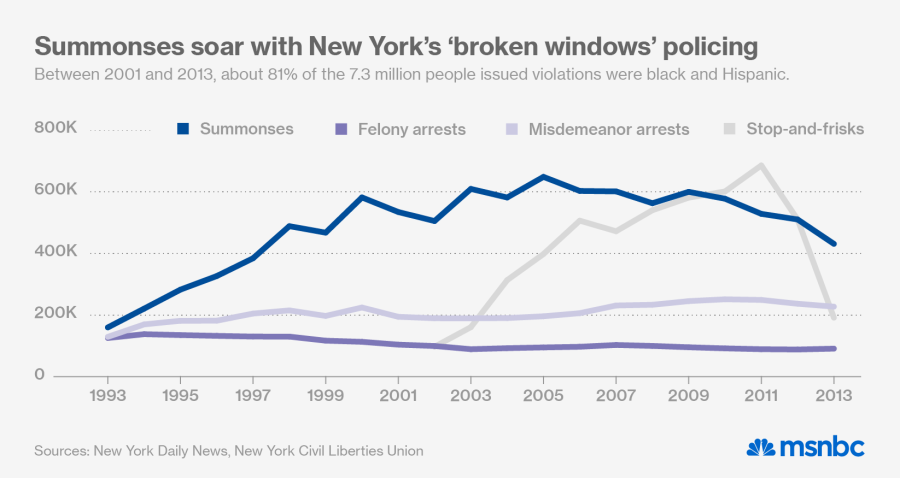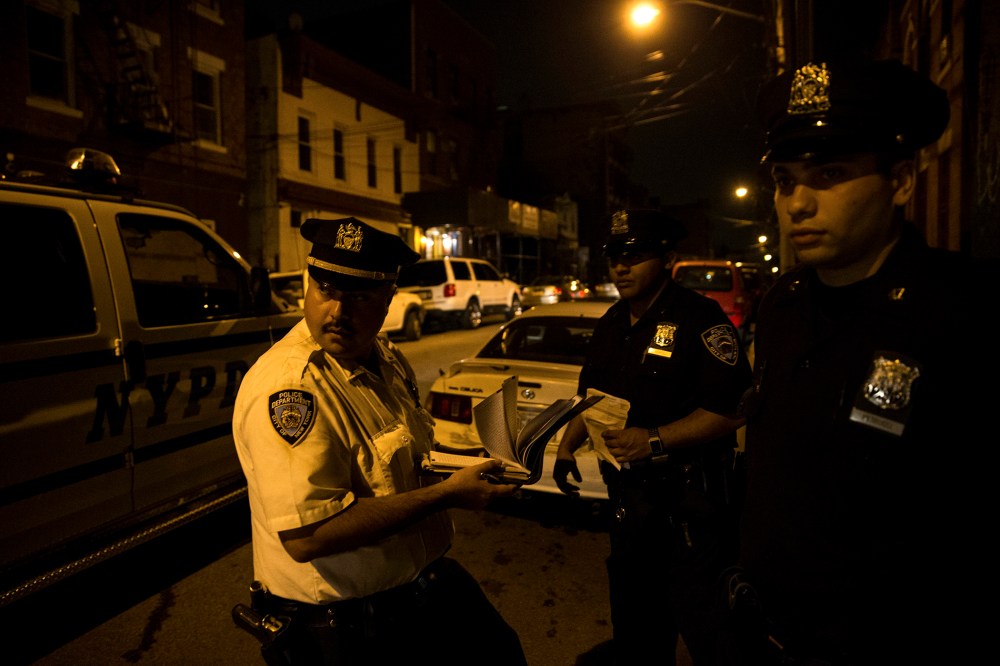The scene was eerily reminiscent of New York City’s bad old days, when the streets were boiling over with racial strife, tension and violence.
A black man is surrounded by a group of NYPD officers. One throws an arm around the black man’s neck from behind. The man is wrestled to the ground. His shouts of “I can’t breathe” are ignored. Then, minutes later, he is dead.
The apparent chokehold death of Eric Garner, who was accused of selling loose, untaxed cigarettes on a Staten Island sidewalk just moments before being accosted by police last month, has reignited a decades-old debate over the NYPD’s so-called “Broken Windows” policing, in which officers aggressively attack minor offenses with the aim of suppressing other crimes.
%22There%E2%80%99s%20something%20disjointed%20about%20what%20the%20mayor%20says%20and%20what%20is%20actually%20happening.%22′
New York’s Democratic Mayor Bill de Blasio was elected on a campaign that rejected controversial police tactics like stop and frisk, an outgrowth of Broken Windows policing that flourished under the previous administration. The tactic disproportionately targeted young black and Latino men for random stops and searches. De Blasio’s commitment to undoing stop and frisk helped to solidify his support among black and brown voters — many felt he offered hope of a paradigm shift in the way the city’s poorer communities would be policed. They all but carried him into City Hall on their shoulders.
In the short time since his inauguration, though, the mayor has been an ardent defender of Broken Windows and his police commissioner Bill Bratton. In the early 1990s, on the tail end of the crack-era, Bratton served as police commissioner under then-mayor Rudy Giuliani. He helped to shape the department’s robust push into communities of color via Broken Windows. Supporters credit the crackdown with driving down crime in the city, though the connection remains foggy at best, since crime has gone down across the country during the same time period in cities that did not employ similar tactics.
But in light of Garner’s death — which began with the paltry offense of selling 50-cent cigarettes on a city street — and all of the controversy kicked up around it, questions have arisen as to how this administration’s policing of communities of color will differ from those that came before it.
“The mayor has made no bones [about] where he is coming from and where his values are in terms of policing. He has an African-American son. He knows what the challenges are for an African-American and a mixed family. He campaigned like he gets it,” said Donna Lieberman, executive director of the New York Civil Liberties Union. “But I think that this issue of Broken Windows policing is something that is a serious problem and we have yet to hear from the mayor that he sees, that he believes, that it carries with it enormous danger and a lack of benefit.”
Lieberman called the administration’s continued practice of Broken Windows policing as “continuing the distrust and the tale of two cities that was the narrative of the prior administration.”
Last week, the city’s medical examiner ruled Garner’s death a homicide. The officer who appeared to place Garner in a chokehold shortly before his death has since been stripped of his badge and gun. Chokehold maneuvers have been banned by the NYPD since 1993. The Staten Island District Attorney’s Office has said prosecutors are still reviewing evidence in the case.
Had Garner not been killed, he likely would have landed on the city’s massive roll of petty violators, the vast majority of whom are black and Hispanic. A recent report by the New York Civil Liberties Union compiled more than a decade’s worth of police data , and it illustrates a stark disparity in exactly who the police have targeted for minor infractions.
According to the NYCLU report and an analysis by the New York Daily News, 81% of the 7.3 million people slapped with low-level summonses between 2001 and 2013 were black and Hispanic. The data includes summonses spanning the whole of Michael Bloomberg’s mayoral term, a period when New York City ramped up an aggressive police campaign in poor, mostly minority communities. Critics of Broken Windows say that countless millions of dollars have been spent on targeting minority and low-income neighborhoods for petty crimes — even while crime by many measures is at an all-time low.
Garner’s death, which was captured by a witness on cellphone video, and a slew of other alleged police abuses in recent weeks have put de Blasio and Bratton under growing scrutiny. De Blasio has defended Broken Windows, saying that unlike random stops, those stopped for minor infractions are suspected of breaking the law.
Yul-san Liem, co-director of the Justice Committee, said the mayor’s rhetoric and what’s actually happening on the ground differ broadly.
“The issue is that this kind of policing is not being applied consistently across the board, that the orientation of the department is to go into specific communities and low income communities of color,” Liem said. “White folk from affluent neighborhoods are not getting stopped and beaten up for jay walking. There’s something disjointed about what the mayor says and what is actually happening.”
Liem said that, while stop and frisk has decreased, recent data suggests that police stops for summonses and misdemeanors are having a similar and disparate impact on minority residents.
%22The%20state%20should%20be%20acting%20in%20cooperation%20with%20communities%20to%20repair%20broken%20windows%20and%20improve%20quality%20of%20life%20instead%20of%20criminalizing%20the%20people%20who%20survive%20the%20persistence%20of%20both.%22′
Over the last decade, as murder and other major crimes including aggravated assault, rape and robbery have all dropped significantly, summonses for petty crimes and misdemeanor arrests including marijuana possession, traffic infractions and noncriminal offenses are way up. The upswing has largely been driven by people caught in possession of a small amount of marijuana, who disproportionately happen to be young men of color.
“This kind of policing, as we’ve seen with the Eric Garner case and the many cases of brutality that have surfaced, this kind of policy can have brutal and fatal consequences,” she said. “The mayor would be keeping with his campaign platform if he were to turn away from it.”
Repeated requests for comment from the mayor’s spokesmen about the issue were not returned by Thursday afternoon.
Per the NYCLU/Daily News reporting around the racial implications behind the issuance of summonses, the number of summonses have skyrocketed since the implementation of Broken Windows policing in the early 1990s. In 1993 there were 160,000 issued compared to a peak of 648,638 in 2005. The number fell to 431,217 last year and continues to trickle downward. But according to the Daily News, writing out summonses for low-level violations make up the majority of police activity, even more than felony and misdemeanor arrests combined.

Last week, the NYCLU sent a letter to Bratton, the chairman of the New York City Civilian Complaint Board, and the city’s Inspector General calling for reforms in the police department. The letter states that beyond the circumstances of Eric Garner’s death, the incident raises a number of other critical issues, including the use of force by police in enforcement of low-level offenses, use of force training within the department, and the NYPD’s lack of responsiveness to substantiated complaints of misconduct.
The NYCLU mined the NYPD’s comprehensive stop-and-frisk database to cobble together a picture of the number and frequency of stops that escalated into use of force by police. During a 10-year span between 2003 and 2013, police officers self-reported 1,381,843 acts of force in 4,984,393 stops. Analysis of stop and frisk has indicated just how ineffective the tactic has been.












